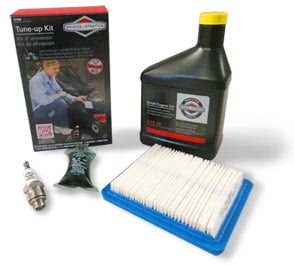You can keep your lawn green, healthy, and thriving all season long by following a consistent care strategy that balances proper fertilization, watering, mowing, and maintenance. Choosing the right fertilizer based on a soil test ensures your lawn gets the nutrients it truly needs, while watering deeply once a week encourages strong root growth. Regular mowing at the right height, quick repairs to damaged areas, and proper aeration all contribute to lush, resilient grass. With tuned-up outdoor power equipment, sharp mower blades, and clean finishing touches, you’ll maintain a beautiful, professional-looking lawn that stands out all year.
1. Strategize before you fertilize.
One of the most common mistakes in lawn care is using a fertilizer that’s not designed for your lawn. Pick up a soil test kit at a home improvement store and then consult with a professional at a local garden center about what fertilizer formula is best for your lawn type and specific yard conditions. For example, in addition to ultra-important nitrogen, your lawn may need a phosphorous or potassium supplement. In some regions, however, these nutrients occur naturally at sufficient levels. Take the time to study fertilizer options.
Related info: Seven killer lawn fertilizer mistakes
2. Water once weekly.
Despite what’s commonly advised, most lawns should not be watered multiple times per week. Frequent watering for short periods causes lawn root systems to stay close to the surface and more susceptible to disease. Instead, lawns should be watered one day per week for a lengthier period to allow for deeper saturation.
3. Don’t cut your lawn too short.
Cut no more than one third of your lawn’s grass blade length in a single mowing. Because grass grows through photosynthesis, taller grass blades mean healthier root systems. Shorter blades are unable to obtain the energy needed. Though you may be tempted to give your lawn a buzz cut to skip a mowing, you’ll ultimately negatively impact the health and vibrancy of your lawn.
4. Fix problems asap.
Study your lawn regularly. Stop weed growth at the first signs. Repair damage. Reseed. Know disease and pest patterns and take action immediately if you spot these on your lawn.
5. Take good care of your outdoor power equipment.
- Tune up small engines to reduce emissions, improve efficiency and performance. Tune-up kits, packed with the essentials for particular models, make it easy. RepairClinic.com has all tune-up kits on sale through May 31, 2014. Enter your lawn mower or other small engine model number on our Great Spring Tune-up Kit Sale page to find the kit recommended for your model.
- Always have sharp lawn mower blades in place, as dull blades tear, rather than cut grass, which results in a yellow hue over the top of lawns.
- Use the string trimmer line that the pros use – star-shaped and other non-round shaped string line – for cleaner cutting.
6. Remove thatch and debris and then aerate.
Thatch is a mix of dead grass and other debris that forms a layer over your lawn. Fortunately, a simple rake will remove thatch. Recycle grass clippings (unless the clippings include crabgrass and weeds). Fertilizer and other lawn care efforts will be ineffective where thatch is present; be sure to remove thatch and other debris before seasonal lawn care.
7. Don’t skimp on the finishing touches.
Use an edger and other handheld outdoor power equipment to give your yard a professionally-manicured appearance.
Related info
Eight simple ways to earn a healthy lawn
7 simple ways to make lawn mowers run like new
Lawn mower maintenance tips
Lawn mower repair help
Comments are closed.